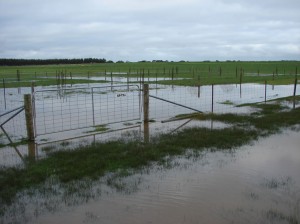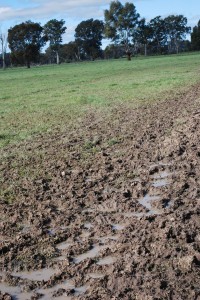Manage wet soils – East Gippsland
The issue

Managing saturated soils in winter and spring can be a major issue for farmers in the high rainfall regions of southern Australia. Pasture productivity can be decreased to the point at which it needs to be completely re-sown in severe cases. Management to prevent serious damage to pastures is essential to maintain productive pastures during wet seasons. There are a number of different options that can be explored to assist in the prevention of pugging in wet paddocks.
What are the options?
There are several options for managing wet soils to reduce pugging. Different grazing techniques to minimise damage can be less costly than designing drainage to cope with the issue. However if soils are extremely wet, any kind of grazing will result in some level of damage. Preventative methods such as surface and sub surface drainage can be used to prevent further water logging in future years and stand off areas for cattle can be used if there is adequate feed available and a suitable area to hold cattle until soils are dry enough to allow grazing.
Selecting the right plant for wet areas
Selecting the right pasture for wet areas can greatly increase productivity of the area as well as water utilisation.
Summer active tall fescue is a deep-rooted temperate perennial grass suited to heavy low-lying soils. It is well adapted to growing in conditions of low oxygen availability and the salinity exchanges that occur when salts in the soil profile are mobilised by rising water, making it persistent in waterlogged conditions.
The EverGraze Hamilton Proof Site investigated the positioning of different pasture species for the crest, slopes and valley floors. Both summer active tall fescue and late-finishing perennial ryegrass were persistent and productive on the wet valley floor. Both summer active tall fescue and Banquet perennial ryegrass were utilized on the valley floor as suitable species to handle waterlogged soils and increase productivity in this area.
Grazing Techniques
By controlling the way cattle move around a paddock and where cattle camp in a paddock, you can control the damage that is done to wet soils during grazing. Different techniques assist you to control the amount of damage that occurs.
On/off grazing
On off grazing systems involve putting cattle onto their daily allocation of feed for a short period of time then removing them to a stand off area. The majority of pugging damage is done to wet soils when cattle are searching for feed. By only allocating a certain amount of feed to cattle daily and removing them when they have finished, generally after four hours, further damage can be prevented.

Stand-off areas are used to get cattle off paddocks and can be a temporary or long term solution depending on the facilities. Stand off areas can include;
- lane ways
- yards
- sacrifice paddock
- feed pads
Animal health should be monitored if using stand-off areas for long periods of time. Care should be taken to make sure all animals have access to feed and water and that all animals have adequate area to move around. Animal condition should be monitored to ensure nutritional requirements are being met and lame, sick or shy-feeding animals are removed and treated separately.
Graze longer pasture and utilize nitrogen
Longer pasture helps to prevent soil damage by acting as a raft between the hoof and the soil, preventing or decreasing pugging although more pasture is wasted through trampling. Longer grass enables animals to eat their allocation quicker, and therefore prevents the need for them to walk to pastures. Pasture also recovers more quickly if it is longer, due to stronger root system reserves for re-growth. Nitrogen (N) fertiliser or gibberelic acid can be used to boost autumn/winter feed availability and therefore increase the length of pastures in the critical period. Care should be taken when deciding when to apply nitrogen – especially in wet soils. Further information on pasture response rates to nitrogen and safe application is available from the University of Melbourne.
Build a feed wedge
Building a feed wedge or a bank of pasture in autumn allows pasture to be at a better height for grazing in winter, and increases the quantity of feed available. This will reduce the amount of supplementary feeding that needs to be done through the winter time and gives more flexibility in grazing what paddocks and when. See Filling the winter feed gap for further information.
Back fence
Strip grazing can be an effective method of preventing damage to previously grazed areas. By back fencing previous grazed sections, cattle can not access the area to create further pugging damage.
Decrease stocking rate
Removing cattle from water logged soils is the best option to reduce damage to wet soils. Cattle can be put onto stand off areas which are not as vulnerable and fed hay or concentrate. Cattle could graze hills if available instead of the flats. Agistment or selling of some stock may also be an option to decrease cattle numbers on affected areas.
Graze larger areas
Increasing the grazing area can reduce damage by reducing the concentration of cattle on the area providing feed is available in the increased area and that cattle don’t concentrate in one area of the paddock.
Improving drainage
Surface drainage
Surface drainage, if put in correctly, will quickly remove surface water from the paddock and can be achieved with simple to complex methods. Methods of surface drainage include;
- Open drains which can vary in width and depth. Drains are usually put in using an excavator and need to be cleaned out periodically to maintain their effectiveness Care needs to be taken to make sure the slope of the drain does not cause erosion.
- Wide grassed waterways are shallow drains that can be narrow to several metres wide. They are grazed with the rest of the paddock and can be placed evenly across paddocks to drain to the lowest point.
- Raised pastures or humps are formed when renovating pastures by creating large convex humps in the paddock so that water sheds from the humps into the shallow surface drains and drains to the lowest point of the paddock.
- Levee banks are raised banks of soil that redirect water flow. They can be used across the contour of hills to redirect water flow into water holding areas and away from erosion or wet areas.
- Laser leveling is an expensive process that involved leveling the whole surface of a pasture so that there is a slight gradient to the lowest point in the paddock.
Sub-surface drainage
Subsurface drainage is an expensive and complex solution to water logged soils. The type of subsurface drainage that is suitable will depend on the soil type, profile and terrain. Dispersive and erosive soil types may not be suitable for this type of drainage.
- Pipe drains are underwater slotted pipes that are often surrounded by gravel and placed across an area to assist with sub surface drainage. They are generally very costly and not suitable for agricultural use
- Mole drains are created using a mole drain machine that creates a unlined drain 40 – 50cm underground. The soil needs to have a relatively high clay content so that the mole drain keeps its structure. The drains act to drain sub surface moisture out to an open drain. Care needs to be taken when implementing a mole drain system because in some slaking soil types tunnel erosion can occur. A case study called ‘Putting mole drains into action’ is available.
- Interceptor drains are gravel drains that usually contain a slotted pipe and are put in using a laser level to allow flow to a water holding area. They are put in at the base of a hill to intercept sub surface water flow and divert it away from flats.
- Ground water pumps can be used to lower the water table and therefore draw down sub surface water. The cost effectiveness of this method needs to be investigated as well as the legality of ground water pumping.
Recovering pastures after pugging
There are different options to recover pastures after pugging damage has occurred and the severity of this damage will dictate the type of recovery required.
- Light – May have a number of options, including rolling when soil conditions are drying. This option is generally only available during a small window of time and on flatter type land.
- Medium – Rolling or smudging. Maybe look at over-sowing if plant density has been affected.
- Heavy/severe – This may require pasture re-sowing or a complete renovation using either a crop grown for silage, hay or summer crop.
- Very severe – Often paddocks that may have been sacrificed or severely wet during rotational grazing. Will need to be cropped or could go back to permanent pasture if clean of annual weeds or can control spring germinating weeds.
Training
The training packages; Whole Farm Grazing Strategies, Nuts and Bolts of grazing strategies, Farm Plan 21 and Prograze, contain information on managing wet soils. View the Training and events area to see what training is available and coming to your area.

